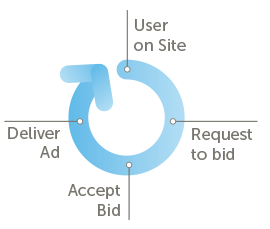
ExactDrive believes Real-time bidding (RTB) can erroneously motivate media buyers to pay lower prices to advertise online while still expecting equal performance.
ExactDrive has recently analyzed the performance and effective bid price (average media cost) of several hundred online advertising campaigns. The results indicate that just because real-time bidding technology is being utilized to advertise online doesn't necessarily mean that the inventory should be purchased at a lower price.
Real-time bidding is a relatively new and very dynamic way to buy online advertising. Real-time bidding technology enables the buying process to be automated where media buyers can evaluate, bid on, and purchase ad inventory on an impression-by-impression basis. As a result, real-time bidding and real-time media buying creates one-to-one connections to consumers with greater scale, effectiveness, and efficiency. However, ExactDrive's internal research shows that Real-time bidding (RTB) could potentially motivate media buyers to erroneously pay lower prices to advertise online while still expecting equal performance,
An example scenario ExactDrive analyzed is the following. A company wanted to run a retargeting campaign using dynamic ads that would show a carousel of the last 5 products a user viewed while visiting their website. This particular client had a good game plan. A) Retargeting is often a high-performing online advertising method that generates a lot of success for clients and B) dynamic ads provide an additional layer of connecting the client's products with potential customers. Every potential customer is unique, so not wasting ad impressions with a "one ad fits all" mentality is a good strategy to have.
Despite having a solid campaign strategy the client had a closed mindset towards the pricing strategy they were willing to accept or test because they knew they were utilizing real-time bidding technology to advertise online in real-time. With this in mind, the client believed they should be able to, "sit back and wait for the almost free high-quality impressions to become available." Well, unfortunately, this strategy is not unique to just this single client. There are thousands and tens of thousands of campaigns following a similar strategy, trying to get the most bang for the campaign's budget.
ExactDrive also came to the conclusion that with so many media buyers trying to purchase cheap but high-quality impressions resulted in driving up the overall price to purchase those impressions. This particular campaign that ExactDrive analyzed was a retargeting campaign so there's already a limited pool of users available to advertise to in the first place. Trying to be aggressively price-conscious only makes the size of the user pool even smaller. Through ExactDrive's research the lower the price the client was willing to bid and pay for a potential impression the higher probability the client experienced in losing the impression auction to someone else, which resulted in no advertisement being displayed to the potential customer at all.
Quality is almost always influenced by price. Yes, it is possible to sit back and be strategic in purchasing media and be price conscious but going under a certain price point will start hurting the quality of the impressions and as a result, can have a negative impact on the overall performance of the campaign. As a result, ExactDrive found that trying to buy impressions at too low of a price can sometimes do more harm than good because a client could be losing out on more new customer revenue than the potential money being saved as a result of buying cheaper impressions. Real-time bidding has its value but it also has its limitations.


